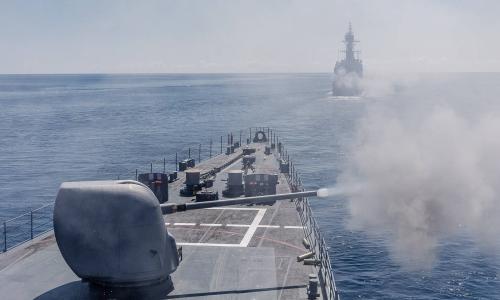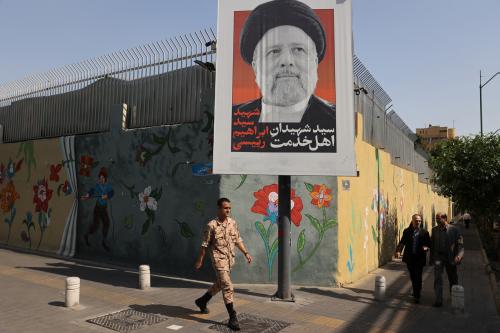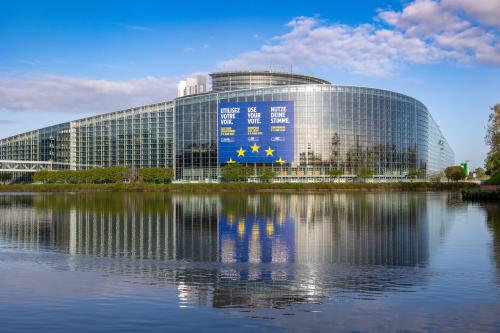The enduring estrangement between the United States and Iran represents the central paradox for American policy in the Persian Gulf. The world has changed dramatically since the 1979 Islamic Revolution gave rise to a religious government in Tehran and ruptured U.S.-Iranian relations. Those changes have been felt even within Iran’s revolutionary politics, through the ascendance of a popular reform movement crystallized by moderate president Mohammad Khatami’s 1997 election. This development prompted an abatement in comprehensive U.S. sanctions and fueled expectations of rapprochement.
But when it comes to U.S.-Iran relations, it seems the more things change, the more they stay the same. Despite Iran’s tentative transformation, the impasse with the United States remains raw and unresolved. Neither Iran’s internal moderation nor Washington’s initiatives have diminished the primary U.S. concerns about Iranian foreign policy—support for terrorism and pursuit of weapons of mass destruction. As President Khatami embarks on his second term, the Bush administration must devise a more effective policy to confront these threats and address the wider scope of U.S. interests in this critical region.
POLICY BRIEF #87
U.S.-Iran Relations: The Track Record
The 1979 revolution transformed Iran from a pillar of U.S. policy and what then-President Jimmy Carter called “an island of stability in one of the more troubled areas of the world” into one of the leading threats to the regional status quo and the international system. Islamic Iran championed the export of its revolution through subversion of its neighbors, terrorism against U.S. allies and interests, and a war waged to defend the country from the 1980 Iraqi invasion. Faced with an implacable adversary, America mobilized an array of policy tools in an approach that eventually led to wholesale political, military, and economic containment of Iran. Nonetheless, some trade continued during the revolutionary government’s first decade, as did sporadic American efforts at engagement—including Reagan-era covert arms sales and former President George Bush’s inaugural suggestion to Tehran that “goodwill begets goodwill.”
But talk of goodwill did not produce clear policy choices, and Iran’s changing politics after the cease-fire with Iraq and the 1989 death of the revolution’s messianic leader, Ayatollah Khomeini, did not decisively alter Iran’s antagonism. President Clinton was confronted with an Iranian regime that had adopted pragmatic tactics, such as constructive nonalignment during the U.S.-led liberation of Kuwait, but remained dogmatically committed to the destruction of Israel and to the acquisition of unconventional weaponry.
Iranian intransigence, particularly on the Arab-Israeli peace process, triggered more strenuous U.S. sanctions under the Clinton administration’s rubric of ‘dual containment’ of Iran and Iraq. Legislation and presidential directives severed most remaining economic ties with Iran in the mid-1990s in an effort to reduce its government’s revenues. Washington sought to expand international adherence to its embargo via diplomatic pressure, most notably through the 1996 Iran-Libya Sanctions Act (ILSA), which threatens secondary sanctions against investors in Iran’s energy sector.
Cooperation from Europe and Iran’s other trading partners proved elusive, however, severely undermining the U.S. effort to economically isolate Iran. Approximately 85 percent of Iran’s foreign exchange derives from oil exports, and given the fungible nature of the oil market, U.S. sanctions have had a negligible effect on Iran’s export revenues and a limited impact on its overall economic development. Meanwhile, the Islamic Republic embarked on a concerted international initiative which—while not mitigating its most problematic policies—substantially enhanced its diplomatic and financial relations with Europe, Japan, and the Arab states of the Persian Gulf.
These countervailing trends—the unilateralism of U.S. sanctions and the intensification of Iran’s international ties—gradually eroded consensus about Washington’s approach to the Islamic Republic and, temporarily at least, discontinued the ‘dual containment’ doctrine and some of its accompanying rhetoric. In its place, the United States has managed its non-relationship with Iran through a combination of political signals, sanctions, incentives, and threat management. The result has been a frustrating exchange of missed opportunities and perceived slights, as well as a continuation—and, in some key areas, an intensification—of the same Iranian policies that America wishes to thwart.
The Basis for the Stand-Off
Washington’s concerns about Iran focus on three areas: support for terrorism; violent opposition to the Middle East peace process; and development of weapons of mass destruction. Secondary American interests include human rights concerns, especially as they relate to Iran’s religious minorities. America has repeatedly asked to address these issues—as well as any raised by the Iranian government—in an authoritative dialogue.
Iran’s position is also well-established: its government has consistently rejected direct diplomatic contacts with Washington while sanctions remain in place and while pre-revolutionary financial claims remain outstanding. Tehran also vigorously disputes the U.S. military presence in the Gulf and a host of American policies toward the region, past and present.
While the differences are clear, the mechanism for addressing them is not. Both sides have expressed divergent demands that effectively negate one another. Washington insists on a government-to-government dialogue before reconsidering its ban on trade and investment, while Iran demands a resumption of economic ties and apparently remains unprepared to condone any normal diplomatic interchange.
Why a New Approach Makes Sense
The impasse is counterproductive for both governments, which stand to gain substantially from even modest improvements to their interaction. Washington and Tehran share key common interests—in managing the threat posed by Saddam Hussein, in stemming the flow of drugs and unrest from Afghanistan, and in establishing greater stability in the troubled Caucasus region—that could be advanced through direct dialogue. Commercial ties would benefit Iran’s troubled economy, while opening to U.S. companies an untapped consumer market and massive energy reserves that are ripe for increased investment.
In the long term, constructive bilateral relations between the two countries would offer even more meaningful gains for America’s strategic interests in the Middle East and Central Asia. Iran has a disproportionately young and well-educated population, situated at the wellspring of the world’s petroleum supplies and at the crossroads of Asia’s emerging democracies and markets. Consequently, Iran is uniquely positioned to enhance the interests of the United States and its allies in a peaceful and economically vibrant future—or, alternatively, to sow greater chaos and instability.
The benefits of an improved relationship may be self-evident, but the path toward rapprochement is fraught with constraints—not the least of which is Tehran’s obdurate rejection of official contact with Washington. More urgently, the escalating cycle of Israeli-Palestinian violence has shattered the fragile beginnings of regional reconciliation and consumed U.S. diplomacy. As a result, the Bush administration’s review of Iran policy falls behind more pressing issues such as the perennial problem of Saddam Hussein.
These obstacles should not deter the administration from adjusting the current approach to better serve U.S. national interests. Containment has failed in each of its objectives: it has not isolated the Islamic Republic, and it has failed to convert the regime to the cause of regional peace or to convince it to forgo the nuclear option. It has alienated our allies, and perpetuated ineffective policies—such as ILSA’s toothless secondary sanctions—simply because of their potential future value as bargaining chips.
Most important, the comprehensive sanctions that are the centerpiece of the current U.S. approach deprive Washington of leverage over Iran’s policies or future trajectory. This leaves America without meaningful instruments to influence a key actor in a region of vital interests and security commitments.
The Bush administration’s review of the existing framework presents an opportunity to set a new agenda for Iran at a critical moment for its future and for the wider region. The administration should take advantage of this opportunity to recast the dynamic between America and the Islamic Republic with measures that encourage greater responsibility and responsiveness from Iran, while maintaining vigilance on proliferation and terrorism.
Interpreting a Changing Iran
The debate about U.S. policy toward Iran inevitably hinges on predicting the unpredictable future of the Islamic Republic. The June 8 presidential elections produced another overwhelming mandate for reform and a second term for the quixotic moderate, President Khatami. The surprisingly large turnout and the president’s unequivocal margin of victory boosted the morale of Iran’s embattled reformers, but also raised the bar on the task ahead. Khatami’s limited authority and powerful opponents will continue to constrain his ability to promote his agenda, which emphasizes civil society and rule of law, or to alter Iran’s stance on the issues of concern to Washington.
The record of the past four years is instructive. Khatami’s first term spawned a modest relaxation in Iran’s strict social taboos, small but significant political reforms, and overdue optimism about the country’s future. But conservatives still control key institutions—the military, judiciary, and state television and radio—and have exerted their authority with a vengeance to restrain reformers and retain their turf. Dedicated to defending the absolute rule of the supreme religious leader, Ayatollah Ali Khamenei, they instigated a backlash after reformist parliamentary victories in February 2000.
With a crackdown on the streets and in the courts, right-wing reactionaries successfully sidelined reformist leaders, silenced progressive publications, and tethered the expansive ambitions sparked by the reformists’ stunning early victories. The intensification of the power struggle also blocked any short-term prospects for U.S. rapprochement.
Despite growing disillusionment with the pace and scope of reform, Khatami’s tenure has provided a genuine and enduring watershed for Iran. His administration has institutionalized popular participation through political parties, competitive campaigns, and the devolution of some central control to elected municipal councils. The reformist parliament, though blocked from legislating greater press protections, has waged a crusade against previously unaccountable state institutions and initiated stepping-stone reforms. Overall, the reform movement transformed the domestic debate from one concerned with whether the Islamic system should change, to one focused on how much and how quickly that change should come.
Even more significant is Iran’s international moderation in recent years. Khatami’s tenure has changed Iran’s perspective on the world in ways that are genuinely significant—if not entirely sufficient. A state that once maintained a stringent stance of nonalignment and preached the inevitability of Islamic revolution now actively courts the world community through its “Dialogue Among Civilizations” initiative and a presidential public relations tour of world capitals. Beyond the hype, the international outreach has entailed a serious convergence among Iran’s political factions to subordinate ideological excesses to the commercial exigencies that were generated by the mid-1990s financial pressures of mounting debts and falling oil prices. The need for better Gulf relations—specifically, Saudi cooperation on oil production and pricing—induced a reversal in Ayatollah Khomeini’s well-established antipathy toward Riyadh, while the effort to attract European investment generated a tacit repudiation of militant policies, including the fatwa against author Salman Rushdie and overseas violence against Iranian opposition groups.
Can Reform Facilitate Rapprochement?
Khatami’s modest progress to date indicates that his second term may achieve greater reform, even on the sensitive terrain of U.S. concerns. His resounding reelection defied widespread expectations and demonstrated the vast shifts in Iran’s political bedrock over the past four years, which endows reformers with much greater leverage than they wielded after their 1997 victory. At home, reformers will build on their institutional strengths by replacing the recalcitrant members of Khatami’s compromise cabinet. Also, domestic reform will find new allies among the conservatives’ pragmatic wing, which is increasingly adjusting to Iran’s new political climate and arguing for change as a religious imperative. This budding consensus should facilitate greater progress, albeit at an exasperatingly slow pace, on restructuring the economy and institutionalizing a rule of law.
On the international front, Khatami’s renewed mandate vindicates his calibrated outreach to the world, an approach that will become even more essential over the next four years. Broad consensus among the political elite supports expanding Iran’s relations with important regional allies, such as India, and developing strategic partnerships with China and Russia. With more than 750,000 Iranians entering the work force annually and an economy that generates far less than half that number of new jobs, the impact of this economic imperative on Iran’s foreign policy will undoubtedly intensify.
Khatami’s reelection alone will not transform Iran. It will not ensure the rights and freedoms that most Iranians consistently demand, or eliminate the egregious elements of Tehran’s international posture. His second term will be subject to the same pressures that have stymied systemic reforms so far, and this may set the stage for an even more intractable stalemate, with conservatives ever more defensive of their power base and reformers increasingly emboldened by an impatient electorate.
But dramatic upheaval is unlikely without extreme provocation or a precipitous decline in oil prices. Khatami’s first term demonstrated the political elite’s aversion to instability, and the population’s reluctance to mobilize for greater change at a faster pace. His reelection confirms that his essential bargain—reform rather than replacement of the system—reflects the basic aspirations of the population. The Islamic Republic will remain in place for now, but its leadership will be under increasing pressure to adopt more responsive domestic policies and a more responsible stance abroad.
Engaging an Uncertain Iran
Iran may be poised for new progress, but political constraints continue to impede any authoritative overtures to advance relations with the United States. A new U.S. approach must deploy a more dexterous mixture of incentives and penalties to draw Iran into a dialogue on the issues of urgent American concern, and to ensure that Iran’s government has an interest in peace and stability beyond its borders.
The use of incentives implies a revision of the prevailing logic that isolation is America’s most powerful weapon. Iran’s contested internal politics and evolving international pragmatism demonstrate convincingly that engagement can be an effective means of maximizing U.S. influence. Iran’s enduring isolation only benefits anti-democratic hardliners and vindicates their world view. In the absence of a political dialogue, initiating modest economic ties with the Islamic Republic will help bring Iran into compliance with international rules and standards, and give its government a greater stake in the region’s future.
Applied judiciously, incentives have helped foster limited moderation in Iranian foreign affairs; trade has provided Europe with an ongoing channel for impressing upon Iran the importance of resolving disputes, such as the dubious prosecution of several Iranian Jews on espionage charges. Commercial ties have also helped facilitate diplomatic relations, as with the recent British-Iranian rapprochement.
Still, the administration must remain realistic about the obstacles to any immediate breakthrough. Iran’s tentative transformation has cultivated buoyant expectations and vocal interests advancing rapprochement. But those who argue that some properly calibrated blueprint can quickly heal the rift are promising more than history demonstrates they can deliver. Ultimately, engagement with the Islamic Republic cannot occur until its leadership chooses that course. America can and should focus on shaping the environment in which Tehran makes that choice.
Six Preliminary Steps for the Bush Administration
A new U.S. approach to Iran should begin with a series of cautious steps that address America’s primary national interests—preventing terrorism and proliferation, ensuring energy security, and promoting human rights, democratization, and regional stability—and which condition further engagement with Iran on its policy responses.
Make Sanctions More Persuasive
The administration should retool the broad unilateral sanctions on trade and investment with Iran to make them more effective and persuasive. Small modifications would demonstrate to the Iranian government the benefits of an improved relationship. Specifically, permitting U.S. companies to open offices, hire local staff, and conduct negotiations in Iran would create greater incentives for future Iranian cooperation. The administration should also level the playing field by allowing American companies to make investments under the $20 million ILSA limit, and permitting executory contracts that are conditioned on further Iranian moderation. Finally, the administration should amend the standing executive orders to permit trade with Iran’s small but potentially vital private sector.
Refine Caspian Policy
Washington has strenuously advocated East-West pipeline routes to preclude Iranian or Russian control of Caspian exports, a stance that provokes Iranian fears of encirclement and isolation. Minor refinements to this position—such as permitting modest oil ‘swaps’ between Central Asia and Iran and involving Iran in discussions on energy transportation between Central and East Asia—could enhance regional development without undermining Washington’s commitment to the routes.
Help Integrate Iran into the World Community
The United States should waive or amend sanctions regulations that require opposition to Iran’s interaction with international financial institutions. Any financial benefits, such as World Bank loans, are paltry compared to Iran’s oil revenues, and the influence of foreign advisors and technical support would boost prospects for market-based reforms that would tangibly benefit Iranians. For the same reason, America should support Iran’s bid to begin accession talks with the World Trade Organization.
Settle Revolutionary Disputes
The Bush administration should expedite negotiations at the Hague tribunal to resolve outstanding financial claims, which primarily consist of Iran’s pre-revolutionary payments for military equipment. This issue has been complicated by recent U.S. civil judgements against Iran for its support of hostage-taking and terrorism abroad. Nonetheless, a committed U.S. approach to negotiations can facilitate a global settlement that would serve the interests of all parties and would eliminate a long-standing irritant to détente.
Encourage Greater People-to-People Contact
People-to-people exchanges, especially on non-political issues such as medicine and the environment, can help cultivate a more informed policy community and enhance individual and institutional incentives for normalization. In addition, the State Department should consider licensing non-governmental organizations to operate in Iran, which would obviate the need for multiple waivers and facilitate greater interaction. The administration should also improve Iranian students’ access to American higher education institutions by improving links, reintroducing standardized tests, and facilitating student visas.
End Fingerprinting
The Bush administration should dispense with the inflammatory practice of fingerprinting all Iranian visitors, which disrupts people-to-people contacts, affronts at least 750,000 Iranian Americans, and is a highly ineffective mechanism for deterring terrorism.
Addressing U.S. Concerns
Clearly, any enduring improvement of U.S.-Iran relations must address established American concerns. In particular, the United States must clearly convey that continuing Iranian assistance to anti-Israeli militants will impede real rapprochement. As long as the intifada rages, flexibility will prove ideologically untenable for Tehran, but given an improved regional context, Iran’s antagonism can be mitigated. Its pragmatic curtailment of violence in the Persian Gulf and Europe demonstrates that terrorism is not an immutable element of Iran’s foreign policy. America must also resolve allegations of Iranian involvement in the 1996 Khobar Towers bombing, which killed 19 U.S. soldiers. Saudi Arabia remains the most viable channel to bring those responsible to justice, but a successful approach must acknowledge Khatami’s own delicate battle to assume greater control over Iran’s security bureaucracy.
Finally, Washington must identify a mechanism for engaging Iran in a dialogue on its nuclear capabilities. Despite Iran’s formal adherence to the NonProliferation Treaty and other arms control covenants, its procurement patterns and missile development leave little doubt about the government’s long-term aspirations. Long-term policy must address the perceptions of threat by all parties, ideally through a regional security dialogue. In the interim, the Bush administration should work with U.S. allies to enhance export controls and other counterproliferation policies, and continue to impress upon Iran the exigency of international concerns.
Beyond the Stalemate
A successful new approach to Iran will require a keener awareness of its negotiating context. Recent American overtures—such as last year’s lifting of sanctions on caviar, carpets, and pistachios—fell short in part because of their explicit empathy for the reform movement. The fundamental lesson of the revolution and its aftermath demonstrates that Washington consistently misgauges and mishandles the intricacies of Iran’s internal politics. Washington should avoid positing its policy on efforts to influence Iran’s ongoing power struggle
Predicating U.S. policy on Iran’s changing circumstances inevitably muddles the relevance of those domestic political cleavages. The convenient dichotomy between ‘good’ reformers and ‘bad’ conservatives is misleading. As recent calls by conservative presidential candidates for improved U.S. relations demonstrate, both camps contain pragmatists who would be prepared to deal with Washington, as well as radicals who reject the international order. For all Iran’s contradictions, America must deal with the regime as broadly construed.
The long rift has cultivated profound Iranian trepidation that any dialogue with the United States will entail evolving and inexhaustible conditions. Many Iranians—even those who have no antipathy toward America—discount the short-term political payoffs of détente, arguing that Iran can compensate by maintaining robust relations with the rest of world. To overcome these misperceptions, the Bush administration review should begin by specifying its expectations of the initial phase of any proposed dialogue, framing the scope of the process, and establishing discrete costs and dividends for future engagement.
There is no magic formula for resolving the rift between the United States and Iran, but past need not be prologue. A new American approach to Iran is long overdue.



